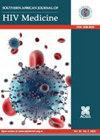Determinants of health-related quality of life in young adults living with perinatally acquired HIV infection in Botswana
IF 2.3
4区 医学
Q4 INFECTIOUS DISEASES
引用次数: 0
Abstract
Background Due to the successful antiretroviral therapy (ART) programme in Botswana, large numbers of perinatally HIV-infected adolescents are emerging into young adulthood. Young adulthood is a critical period of human development. However, there is lack of information on the factors affecting the health-related quality of life (HRQOL) of young adults living with perinatally acquired HIV (YALPH) in Botswana. Objectives The objective of this study was to assess the HRQOL and its determinants among YALPH who were enrolled on ART at Botswana-Baylor Children’s Clinical Centre of Excellence in Gaborone, Botswana. Method A cross-sectional study assessed the HRQOL of 509 YALPH aged 18–30 years using the WHOQOL-HIV BREF. Data about other variables of interest were abstracted from medical records. Bivariate analyses were performed using t and Chi-square tests to determine the associations between demographic and clinical variables and general HRQOL. The variables that were associated with the general HRQOL at P-value < 0.1 were included in the multivariable analysis using the logistic regression approach. Results The majority of participants had good general HRQOL (78.4%). The highest mean HRQOL score was in the Physical domain (5.4 [± 2.9]) and the lowest in the Environment domain (13.8 [± 2.7]). The factors that were significantly associated with the general HRQOL included: level of education attained (P = 0.012), employment status (P = 0.069), viral load suppression (P = 0.073) and self-reported illness (P = 0.001). Conclusion Interventions that effectively increase educational attainment, employment opportunities, ART adherence, and prevention or management of illness are needed to promote good HRQOL among YALPH in Botswana.博茨瓦纳围产期获得性艾滋病毒感染青年健康相关生活质量的决定因素
背景由于博茨瓦纳成功的抗逆转录病毒疗法(ART)计划,大量围产期感染艾滋病毒的青少年正在步入成年。青年期是人类发展的关键时期。然而,博茨瓦纳缺乏关于影响围产期获得性艾滋病毒感染者健康相关生活质量的因素的信息。目的本研究的目的是评估在博茨瓦纳哈博罗内的博茨瓦纳贝勒儿童临床卓越中心参加ART的YALPH患者的HRQOL及其决定因素。方法一项横断面研究使用WHOQOL-HIV BREF对509名18-30岁YALPH的HRQOL进行了评估。关于其他感兴趣的变量的数据是从医疗记录中提取的。使用t和卡方检验进行双变量分析,以确定人口统计学和临床变量与一般HRQOL之间的相关性。使用逻辑回归方法将P值<0.1时与一般HRQOL相关的变量纳入多变量分析。结果大多数参与者的总体HRQOL良好(78.4%)。平均HRQOL得分最高的是物理领域(5.4[±2.9]),最低的是环境领域(13.8[±2.7]),病毒载量抑制(P=0.073)和自我报告的疾病(P=0.001)。结论需要有效提高教育程度、就业机会、ART依从性和疾病预防或管理的干预措施,以促进博茨瓦纳YALPH患者良好的HRQOL。
本文章由计算机程序翻译,如有差异,请以英文原文为准。
求助全文
约1分钟内获得全文
求助全文
来源期刊
CiteScore
2.80
自引率
11.80%
发文量
41
审稿时长
>12 weeks
期刊介绍:
The Southern African Journal of HIV Medicine is focused on HIV/AIDS treatment, prevention and related topics relevant to clinical and public health practice. The purpose of the journal is to disseminate original research results and to support high-level learning related to HIV Medicine. It publishes original research articles, editorials, case reports/case series, reviews of state-of-the-art clinical practice, and correspondence.

 求助内容:
求助内容: 应助结果提醒方式:
应助结果提醒方式:


